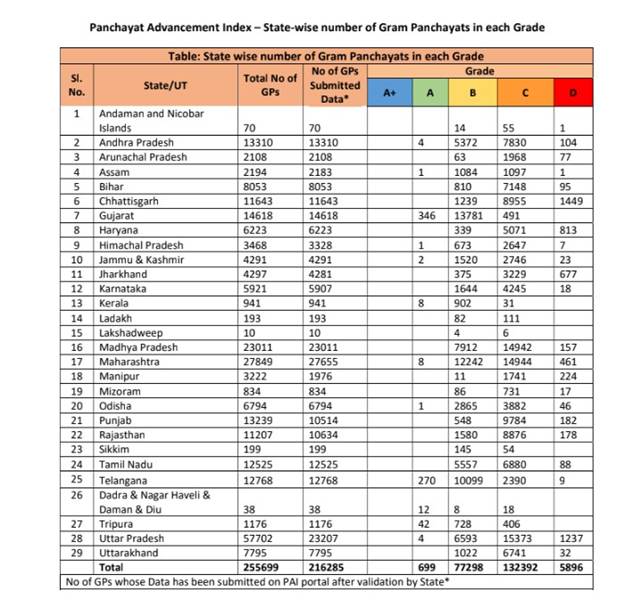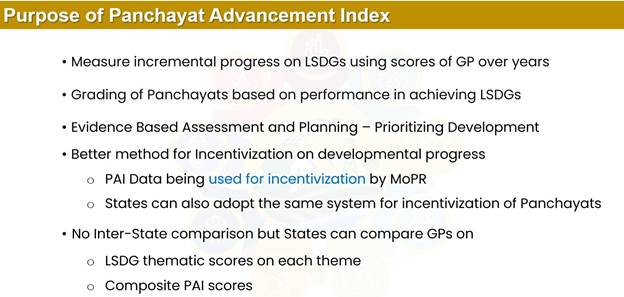Ministry of Panchayati Raj
Evidence-Based Rural Development Gets a Push with Rollout of First-Ever Panchayat Advancement Index (PAI) Baseline Report for FY 2022-23
PAI 2022–23: Out of 2.16 Lakh Validated Panchayats, 35.8% Gram Panchayats Recognized as Performers; 61.2% Identified as Aspirants; Gujarat and Telangana Lead as Front Runners
Posted On:
09 APR 2025 1:43PM by PIB Delhi
In a major stride towards localizing Sustainable Development Goals (SDGs) and empowering grassroots governance, the Ministry of Panchayati Raj has launched the Panchayat Advancement Index (PAI) — a transformative tool to measure the progress of over 2.5 lakh Gram Panchayats (GPs) across India. The PAI captures Panchayats’ performance across nine themes of Localized SDGs (LSDGs) ie. Poverty-Free and Enhanced Livelihoods in Panchayat, Healthy Panchayat, Child-Friendly Panchayat, Water-Sufficient Panchayat, Clean and Green Panchayat, Panchayat with Self-Sufficient Infrastructure, Socially Just and Socially Secured Panchayat, Panchayat with Good Governance and Women-Friendly Panchayat. These themes align global goals with rural realities, helping local governments tailor their strategies for holistic development.
State-wise, Gujarat led the pack with 346 Gram Panchayat as Front Runners, followed by Telangana with 270 Front Runners. States with a high number of Performers include Gujarat (13781), Maharashtra (12,242), Telangana (10099) along with Madhya Pradesh (7,912), and Uttar Pradesh (6593) while Bihar, Chhattisgarh, and Andhra Pradesh have a significant share of Aspirant Gram Panchayats, highlighting areas needing focused development efforts. The 2022-23 PAI data reveals that out of 2,55,699 Gram Panchayats, 2,16,285 submitted validated data. While 699 (0.3%) Panchayats emerged as Front Runners, 77,298 (35.8%) were Performers, 1,32,392 (61.2%) were Aspirants while 5,896(2.7%) Gram Panchayats were at the Beginner Level. None of the Gram Panchayat is qualified as an Achiever. As of now, no inter-state comparison has been done.
About Panchayat Advancement Index
Panchayat Advancement Index (PAI) is a composite Index & has been compiled based on 435 unique local Indicators (331 mandatory & 104 optional) consisting of 566 unique data points across 9 themes of LSDGs (Localization of Sustainable Development Goals) aligned with National Indicator Framework (NIF) of the Ministry of Statistics and Programme Implementation (MoSPI) , the PAI reflects India’s commitment to achieving the SDG 2030 Agenda through participatory, bottom-up development. Based on the PAI scores & thematic Scores achieved by different Gram Panchayats, these GPs are grouped into one of the categories of performance – Achiever: (90+), Front Runner: (75 to below 90); Performer: (60 to below 75); Aspirant: (40 to below 60) and Beginners (below 40).
PAI aims to assess and measure the progress made by grassroots-level institutions in achieving localized SDGs, thereby contributing to the attainment of SDG 2030. The Panchayat Advancement Index (PAI) is a multi-domain and multi-sectoral index that is intended to be used to assess the overall holistic development, performance & progress of Panchayats. The index takes into account various socio-economic indicators and parameters to gauge the well-being and development status of the local communities within the jurisdiction of a Panchayat. One of the purposes of the PAI is to identify the development gaps of the Panchayats through the scores achieved across various LSDG themes and enable the Panchayat for evidence-based planning at grassroots level. The outcomes of the PAI, over time, will reflect incremental progress based on the scores achieved by Panchayats, highlighting their advancement toward realizing the LSDGs. The first ever baseline Panchayat Advancement Index (PAI) FY 22-23, will play a vital role in setting local targets, identifying actionable points, and facilitating the preparation of evidence-based Panchayat Development Plans aimed at achieving the desired goals. The index resonates with the needs of rural India making them contextually meaningful at the grassroots level. The PAI serves as a tool for assessment and promotes healthy competition among Panchayats. Moreover, the data collected through PAI serves as a foundation for evidence-based planning, enabling Panchayats to identify development gaps, set clear targets, and allocate resources more effectively, thus driving more strategic and impactful governance at the local level. Crucially, it enables policymakers at all levels from State Governments to Members of Parliament to assess ground-level progress and fine-tune strategies accordingly.
Release of the Panchayat Advancement Index has been possible due to the collaboration with various Union Ministries, State Governments and UN Agencies. These stakeholders have shared essential data that forms the backbone of the index, making it a comprehensive tool for monitoring development. Over 2.16 lakh Gram Panchayats from 29 States/UTs have already entered their data into the dedicated PAI Portal with each entry rigorously validated before being included in the final index. The PAI portal (www.pai.gov.in) serves as a robust, multilingual data management platform enabling Panchayats to enter and track their development metrics. Data from over 2.16 lakh Panchayats has been processed, with validation by States/ UTs. Data for 11,712 Panchayats from five States/UTs (Meghalaya, Nagaland, Goa, Puducherry, and West Bengal) were not included due to pending validation.
As India continues its journey towards the 2030 SDG targets, the PAI stands as a landmark innovation in rural governance promoting transparency, efficiency, and community-centered development. For further insights and access to detailed reports, visit www.pai.gov.in.
State Wise Number of Panchayats in Each Performance Category



For List of Top 25 GPs across India: Click Here
****
Aditi Agrawal
(Release ID: 2120320)